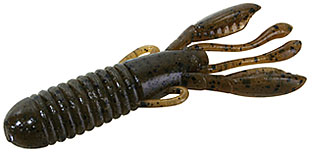
The more Jackall products I use, the more I like them. This time I'm reporting on the Jackall Cover Craw. This is a unique soft bait. It is salt injected with a live bait scent, has a profile that is thicker than other soft craw baits and has a very soft texture. It comes in eight popular colors and two sizes; Three and four inch. I have used only the four-inch size, but from my initial outing with them, I plan on using the three-inch versions as well.
Traditionally, most anglers, myself included, will rig a soft craw bait with the hook eye on the tail end, presenting the bait in the same manner as a crawfish swims; that is, tail first. The Cover Craw is designed to do the exact opposite. Rig it on a 4/0 or 5/0 EWG hook with the hook eye at the head of the bait, between the claws and without any weight. When rigged weightless and "backwards", the Cover Craw glides away from you and will back itself under docks, trees, bushes or just about anything with water under it. Forget the days of just fishing the edges of docks and overhangs, the Cover Craw will get you closer to where the fish are, all on its own. The sink rate is moderate but not exceptionally slow. The fish get a quick glance and they have a split second to make a decision as the Cover Craw slides past them.
Once on the bottom, with an upward 'tip up' and sudden 'let off' of the rod, the Cover Craw, with appendages in motion, lifts off the bottom, then floats enticingly back towards the bottom, away from you and right back into the face of any fish that may be following. This is a very effective and simple technique that helped me catch more than a few bass this spring, especially in the pre-spawn period. I had found several areas that the bass used to guide them to the shallow spawning flats. These areas were in six to ten feet of water. I would cast parallel into these channels and work it with the 'tip up, let off' technique. I wouldn't reel any slack until just before I made a 'tip up." This allowed the bait enough slack after the 'tip up' to fall freely on it's own to the bottom without any interference. I found that most of the bites I got were after I let off and it started the backwards glide to the bottom. You really have to watch your line with these baits because of the unique sliding action. I also managed to catch a couple of decent fish with it rigged traditionally on a Carolina Rig, dragging it along the bottom across some rocky points. It is a versatile bait and can be fished in a number of different situations.
Once the bass move onto the deep docks and into their summer patterns, I expect the Cover Craw to become even more effective than the way I bottom fished it this spring. The sliding and gliding action should work wonders on suspended fish. You might want to get some before every angler on the lake is throwing a Cover Craw.
Please practice Catch and Release
